Serviços Personalizados
Journal
Artigo
Indicadores
-
 Citado por SciELO
Citado por SciELO -
 Acessos
Acessos
Links relacionados
-
 Citado por Google
Citado por Google -
 Similares em
SciELO
Similares em
SciELO -
 Similares em Google
Similares em Google
Compartilhar
Earth Sciences Research Journal
versão impressa ISSN 1794-6190
Earth Sci. Res. J. v.9 n.1 Bogotá jan./jun. 2005
LUIS LEONARDO MALAVER1 and LUIS ALFREDO MONTES2
1Research Group in Geophysics, Universidad Nacional de Colombia, e-mail: llmalaverc@unal.edu.co
2Associate profesor, Universidad Nacional de Colombia, e-mail: lamontesv@unal.edu.co
ABSTRACT
This paper presents a deterministic two-step approach for the attenuation of ground-roll: modeling the ground-roll response and subtracting it from the recorded shot gather. The first step requires an elastic model of the shallow subsurface, which is created by estimating the p-wave velocity from the first arrivals or uphole times and the s-wave velocity from the ground-roll itself. A finite difference program simulates the elastic wave propagation in the model, providing both an acoustic seismogram and elastic one which contains the ground-roll and also the acoustic response. The provided seismograms are numerically subtracted trace by trace to furnish the isolated ground-roll. The method was applied to records from a Colombian foothill area. These records are contaminated with strong, dispersive, spatially aliased ground-roll that overwhelms the subsurface reflections. The results show that the method provides a better attenuation of ground-roll than those standard techniques such as low-cut frequency filters or f-k filtering, but it does so without sacrificing the low frequency component of data and without causing any distortion in seismic signal.
Key Words: Ground roll, wave equation, finite differences, modeling, filters.
RESUMEN
En este artículo se presenta un esquema determinístico de atenuación de ondas superficiales (Ground-roll) que consta de dos pasos: modelamiento elástico del Ground-roll y substracción de este ruido del registro sísmico original. El primer paso requiere un modelo elástico de la capa somera, el cual se obtiene a partir de las velocidades de la ondas acústica (onda P) y de cizalla (onda S), estimables a partir de los primeros arribos y del ground-roll presente en el registro. Un programa simula la propagación de la onda elástica en el modelo generando un sismograma acústico y otro elástico que contiene tanto el Ground-roll como la respuesta acústica. La substracción numérica traza a traza entre estos sismogramas suministra el ground-roll. La metodología se aplicó a registros del piedemonte Colombiano logrando una mejor atenuación del Ground-roll que la obtenida por métodos convencionales como el uso de filtros de bajas frecuencias o del dominio f-k. Los resultados muestran que la atenuación del Ground-roll se logra sin afectar las bajas frecuencias propias de los datos y sin distorsionar la señal sísmica de interés.
Palabras clave: Ground roll, Ecuación de Onda, Diferencias Finitas, Modelamiento, filtros.
INTRODUCTION
Land seismic data is commonly contaminated with strong coherent noise such as multiples, ground-roll, converted waves, etc. This noise interferes and masks the depth subsurface signal in seismic gathers (Linville, A., & Meck, R., 1995). Near surface lateral velocity variations, in particular, create strong dispersive surface waves that overwhelm the useful information in a shot gather. Band pass and f-k filters are routinely applied in seismic data processing to remove coherent noise while attempting to preserve the signal amplitude and phase. These methods are based on the possibility of separating the signal and noise based on their distinguishing characteristics such as frequency content (bandpass filter) or apparent moveout (f-k filtering and radon transform) (Yilmaz, 1991).
Other techniques developed to reduce the effects of the ground-roll in the seismic records exploit their shallow penetration into the ground such as the so-called associated deep filtering (McMechan and Sun, 1991). In this method the energy of the guided wave is separated from the reflections of the deep horizons by downward extrapolation in time to a depth below which the ground-roll is no longer present, followed by a mute of the shallow events (the ground-roll). This technique can be effective, but can also introduce distortions in the wavefield if an appropriate sampling is not used and it is difficult to extent to 3D data (Ernst et al., 2002). In the frequency–wavenumber domain (f-k) all linear events with a same apparent velocity are mapped to a line with the same slope. Under normal conditions the reflections of the deep horizons are located in the high-velocity region and the surface waves in the region of low velocity. The surface waves can be removed in principle applying a muting window in the region of low velocities in the f-k domain (Treitel et. al., 1967). Due to the complexity of the medium conditions, commonly in the hillside areas the separation between the signal and the noise is not well given, also the levels of the signal are very low and the performance of these algorithms is limited.
Other methods to discriminate between the reflections of the deep horizons and the ground–roll are based on polarization. These methods need information with multicomponents that are not even available in many areas. Additionally the state of polarization of the surface waves can also be irregular (Ernst et al., 1998). In contrast with the conventional methods of noise suppression mentioned above, deterministic scheme have been proposed recently based on wave theory to model the physics of the wave phenomena we wish to eliminate (Ernst, et. al., 1998; Blonk, et. al., 1995; Blonk & Herman 1994). Because coherent noise is generated by a specific, well-known physical mechanism, it is possible to model if an accurate subsurface model in terms of velocity and density is available. Thus, ground roll removal becomes a two step process, i.e., modeling and then subtracting the noise from the shot gather.
In this paper an approach based in noise prediction to remove ground roll from shot gather is presented.
P-SV WAVE PROPAGATION MODELING
Rather than using the wave equation, which is a second order hyperbolic system, we start with the elastodynamic equations of a linearly elastic and isotropic medium:
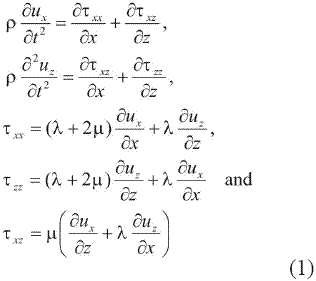
Here, (ux, uz) is the displacement vector, (τxx, τxz, τzz) is the stress tensor, ρ(x,z) is the density and the couple µ(x,z) λ(x,z) are the Lamé coefficients. Introducing the vector velocity the system of equations (1) becomes:
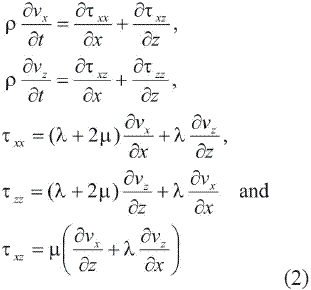
This is a first order coupled set of equations for velocity and stress which can be solved numerically. The compressional and shear velocities are respectively given by expressions:

The medium is assumed in equilibrium initially, i.e. stress and velocity are set to zero everywhere in the medium at time t=0. Due to these initial conditions, propagating stress and velocity is equivalent to propagating time integrated stress” and displacement (Virieux, 1986). A development of finite differences for system (2) can be seen in Appendix A of Levander (1988), where a second order in time and fourth order in space O(∆t2, ∆h4) were stated, with the stability criterion .Δt<0.606h/a
GENERATING THE GROUND ROLL
First, a simple 2D model with two layers (see Figure 1) was used to generate synthetic ground-roll in order to asses the performance of the proposed approach. Two synthetic records were generated with a source placed 10 m below free surface: the first one with non zero shear velocity, simulates a shot in an elastic medium (Figure 2), whereas a second one with zero shear velocity simulates a shot in an acoustic medium (Figure 3).
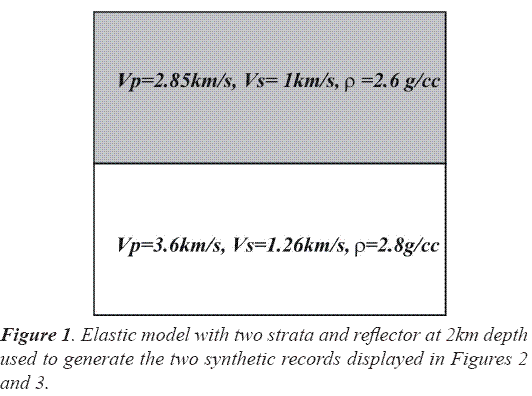
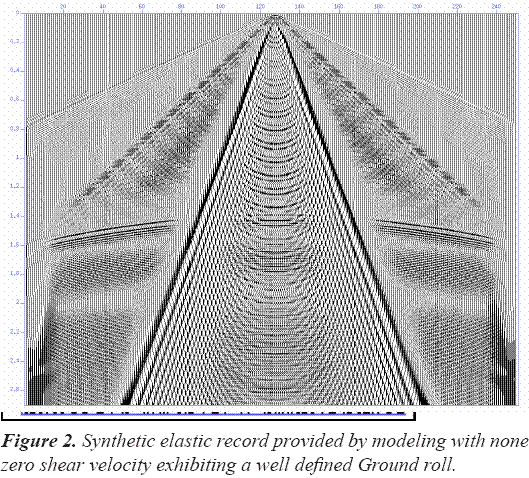
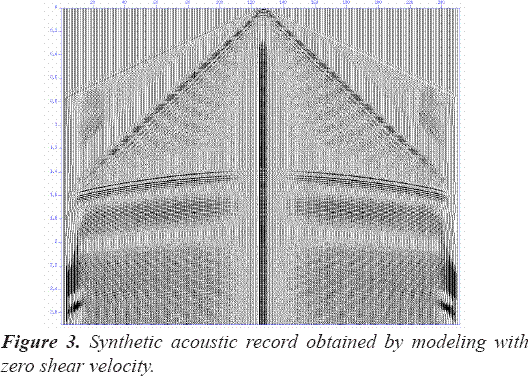
The figure 2 shows the non zero shear velocity shot record, where some events are distinguishable, i.e. direct wave, ground -roll forming a shadow cone and a primary reflection between 1.4 - 1.6 ms. The reflective horizon is partially covered by the ground-roll cone and exhibits lack of continuity between the channels 78 - 174. Also, strong numerical dispersion noise and boundary effects originated when the wave hits the model boundaries are present. The ghost events caused by the boundary conditions are being investigated in a concurrent project (Ghisays, 2005).
Figure 3 displays the record generated with zero shear velocity simulating an acoustic phenomena, it is remarkable the absence of ground-roll in the record and the better continuity of the reflective event in the interval 1.4 - 1.6 ms and between the channels 78 The synthetic ground-roll-free record was subtracted from the synthetic record (Figure 2) yielding the ground-roll model shown in Figure 4. In real data application this isolated cone is obtained through this procedure from a model estimated from real seismic data.
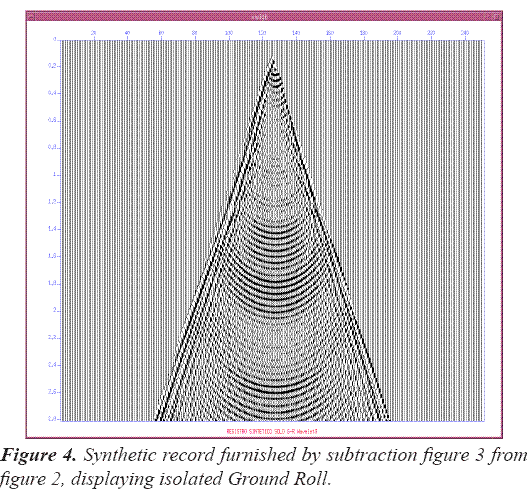
METHODOLOGY
The used methodology is divided in two main steps: the first one build a shallow elastic model, estimating p-wave velocity from first arrivals or uphole time in seismic records and measuring swave velocity from the ground-roll cone in the seismic record. Besides that the source wavelet is extracted from each shot record. Finally using the finite difference software the isolated Ground roll is generated according the procedure mentioned before. In the second step the generated ground-roll is subtracted numerically trace by trace from the respective raw shot gather. As result a shot gather with an attenuated ground-roll is obtained.
In order to asses the level of ground-roll attenuation provided by the method. We compare it with the results obtained with more industry-standard techniques. The same raw shot was filtered using the same Band pass and f-k filters used during the seismic processing of the line. The next section discusses the results.
DISCUSIONS AND RESULTS
The proposed approach was applied to 30 shot records from a 2D seismic line of the Colombian foothill are. The data was acquired with an explosive source at 10 m depth, 15 m group interval, 15 m shot interval, 250 channels and 5 s record length. The raw shot gather in Figure 5 is contaminated by a strong ground-roll whereas Figure 6 displays the same record after ground-roll has been attenuated.
Although the Ground roll is not completely removed due to the dispersive nature of the phenomena and the algorithm limitations to model all relevant aspects of the problem, much of the noise is indeed removed and the reflections can now be seen through most of the record. It is important to realize that the attenuation of the ground-roll has been achieved without distortion of the signal. All reflections in Figure 6 have the same phase and frequency content than corresponding reflections in Figure 5.
For comparison, Figure 7 shows the same shot record filtered with a trapezoidal filter with frequencies 8-12-70-90 Hz, whereas Figure 8 displays the same shot gather after f-k filter. Low-cut frequency filtering succeeds at attenuating the lowest frequency components of the ground-roll, but the low frequency components of the signal are removed along with it. Therefore, we do not see a clear improvement in the continuity of the reflections under the noise cone in Figure 7, as we didi in Figure 6. A similar conclusion can be drawn by carefully examination of Figure 8. Although the ground-roll was attenuated, the reflections are not clearly recovered under the noise cone. Moreover, the f-k filtering process has added some noise to the record, probably due to irregular, sharp mute required to attenuate the ground-roll.
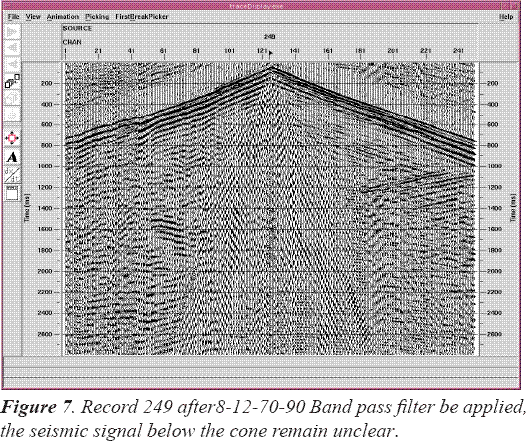
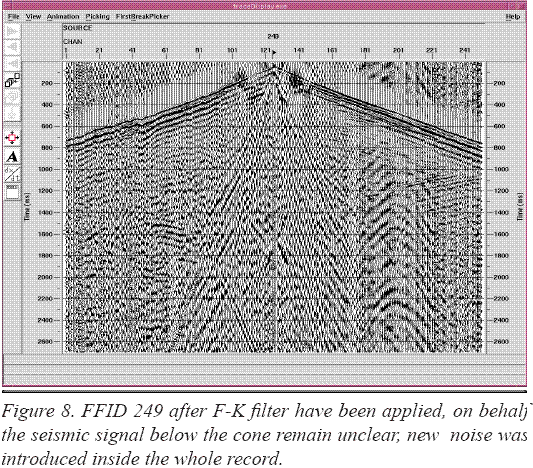
CONCLUSIONS
Modeling and subtracting the ground-roll may be more effective than traditional bandpass filtering or f-k filtering to attenuate the ground-roll cone in real shot records. Not only is the ground-roll more attenuated, but just as important, the integrity of the signal, in terms of phase and frequency content is preserved. The most critical aspect of the method is the accurate estimation of the shallow elastic model required to generate the ground-roll. The accurate extraction of the wavelet is another source of potential inaccuracies.
Attenuating the ground-roll, without distorting the weak reflection is very important for an accurate and faithful interpretation of data.
ACKNOWLEDGMENTS
We wish to thank the National Division for Research - DIB of the National University of Colombia, for providing financial support. This project is a part of the larger project “Modeling of Seismic dispersion phenomena associated to the Topography and the near-surface layers of the subsurface”, partially funded by COLCIENCIAS, the National University of Colombia and the Colombian Petroleum Company - ECOPETROL.
BIBLIOGRAPHY
Aki, K. and Richards, P.G., 1980. Quantitative Seismology, Theory and methods: W.H. Freeman and Company. [ Links ]
Blonk, B., 1995. Removal of scattered surface waves from seismic data: Ph.D. Thesis, Delft Univ. [ Links ]
Blonk, B., Herman, G. C., 1994. Inverse scattering of surface waves: A new look at surface consistency; Geophysics, 59, 963- 972. [ Links ]
Dagosto, C., Marfurt, K. and Steven, J., 2002. Modeling and removal of Ground Roll from horizontal component of C-waves. SEG. [ Links ]
Ernst, F., and Herman, G., 1998. Removal of guided waves from seismic data in laterally varying media: Wave Motion, 173-189. [ Links ]
Ernst, F., Herman, G and Ditzel, A., 2002. Removal of scattered waves from seismic data, Geophysics, 67, 1240-1248. [ Links ]
Ghisays Alfredo., 2005. Fronteras no reflectivas en límites de modelos Sísmicos. Tesis de Maestría. Universidad Nacional de Colombia. [ Links ]
Larner, K., Chanbers, R., Yank, M., and Wai, W., 1983. Coherent noise marine seismic data: Geophysics, 48, 869-874. [ Links ]
Levander, A. R, 1988. Fourth-order finite diference P-SV seismograms: Geophysics 53, 1425-1436. [ Links ]
Linville, A., and Meek, R., 1995. A procedure for optimally removing localized coherent noise: Geophysics, 60, 191-203. [ Links ]
McMechan, G., and Sun, R., 1991. Depth filtering of breaks and Ground Roll: Geophysics, 56, 390-396. [ Links ]
Sheriff, R, E., and Geldart, L, P., 1991. Exploration Seismology: History, theory and obtaining of data.V1,2, 51-60. [ Links ]
Treitel, S., Shanks, J., and Fraiser, C., 1967. Some aspects of fan filtering: Geophysics, 32, 789 - 800. [ Links ]
Yilmaz, O., 1991. Seismic Data Processing; Investigations geophysics 2. SEG. [ Links ]














